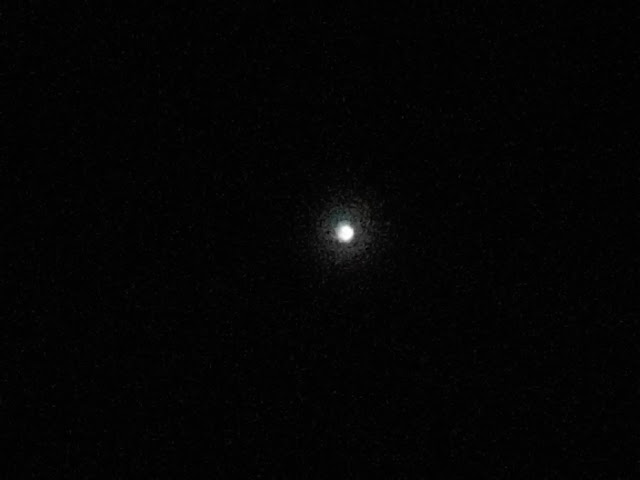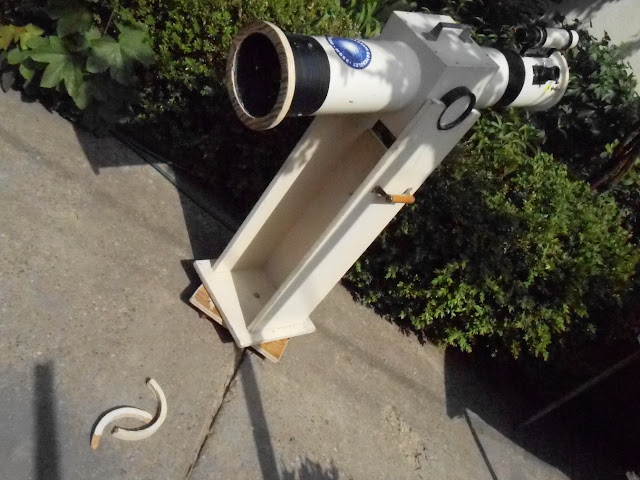Pentru poze am folosit camera compacta Coolpix S3300 pe trepied foto bricolat.
 |
| Halou lunar 6 Februarie 2020 |
 |
| Halou lunar 6 Februarie a.c. |
Am luat imediat ''sapuniera'' mea Coolpix S3300 si am observat, vizual si fotografic, acest halou lunar care a fost foarte persistent ,durata lui depasind trei ore.
 |
| Halou lunar 7 Martie 2020 |
 |
| Halou lunar 7 Martie a.c. |
 |
| Halou lunar 7 Martie |
Cu decenii in urma, pe vremea lui Ceausescu, doar rareori de gaseau binocluri de vanzare - de pilda 8x30mm, rusesti iar costul lor era prohibitiv (cam cat un salariu sau mai mare).
Am incercat atunci sa confectionez un binoclu galilean, folosind o pereche de lentile plan-convexe ca obiective si cu doua lentile divergente echiconcave drept oculare.Lentilele divergente proveneau dintr-un binoclu jucarie.
Grosismentul binoclului urma sa fie foarte redus ,undeva pe la 2.5x.
Am avansat binisor cu proiectul, colegii mei de servici confectionand pe strung tuburile principale pentru obiective si cele culisante, pentru oculare.
Urma acum asamblarea celor doua tuburi principale si pentru aceasta a trebuit sa duc la servici unul din subansamble pentru a fi gaurit pe masina de gaurit in coordonate.
Dupa asamblare provizorie,colimare,testare si trasare, urma gaurirea celui de al doilea tub si apoi trebuia sa fac asamblarea finala.
Din pacate, cineva (vreun nemernic care oricum nu a putut sa faca mare lucru cu ele), a sustras intr-o noapte lentilele unuia din subansamble ,aflat in sertarul biroului meu .Astfel proiectul, ramas fara lentile, a capotat.
Cu timpul, subansamblul ramas fara lentile a fost facut cadou amicului Csillag iar pe cel ramas intreg l-am folosit ,rar, drept ''luneta olandeza''.
O ''luneta olandeza'' este o luneta galileana cu grosismentul mai mic decat grosismentul echipupilar.
 |
| Luneta olandeza cu puterea de marire de 2,5x |
De curand insa mi-a venit ideea de a imbunatati aceasta luneta care ,din cauza obiectivului simplet , trebuia diafragmata la apertura de 20mm pentru ca aberatia cromatica sa fie (cat de cat ) suportabila.
Am schimbat asadar obiectivul simplet de 60mm diametru (vizibil in fotografia urmatoare in stanga sus,langa diafragma de 20mm) cu un obiectiv dublet acromat (stanga, mijloc), provenit dintr-un binoclu si avand parametrii de baza : D liber = 50mm , F= 190mm.
Ocularul a ramasa acelasi ,avand f= -50mm (dreapta,mijloc).
De la obiectivul de binoclu am refolosit celula metalica (stanga ,jos) dar aceasta are diametrul mai mic decat interiorul corpului lunetei.
Am compensat diferenta dintre acesti doi diametrii cu un inel confectionat dintr-un segment de tub de carton ,vopsit negru mat dupa ajustare (inelul se vede in fotografie gata montat pe celula obiectivului de binoclu).
 |
| Luneta olandeza 3,8x |
 |
| Luneta olandeza 3,8x50mm |
G = focala obiectiv/focala ocular = 190/ 50 = 3,8x
O caracteristica a lunetelor olandeze este dependenta campului lor vizual de diametrele obiectivelor.
Cu cat diametrul obiectivului este mai mare, cu atat campul este mai mare.
Aceasta inseamna ca diametrul obiectivului este mult mai mare decat cel cerut de grosismentul echipupilar.
Verificat prin observarea obiectelor ceresti, campul acestei lunete olandeze este de 3.5 grade, imaginea sa este clara, contrastul este bun, cu o buna saturatie a culorilor.
Iata un mic instrument utilizabil, confectionat din parti disparate care zaceau uitate prin unghere.
Dar oare se poate vedea ''ceva'' cu un asemenea instrument minimal ?


































































